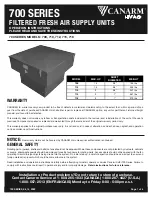
Using the Z Vent Ventilator
4-12
www.zoll.com
9650-002360-01 Rev. A
Control Parameter (I:E or Ti)
The control parameter allows you to select between I:E ratio and Ti. The control parameter you
select is displayed in the parameter window and the parameter you are measuring is always
calculated and shown in the auxiliary boxes.
For AC and SIMV ventilation modes, control breaths are time-triggered and
time-cycled. The ventilator uses the inspiratory time (Ti) parameter setting to terminate the
breath being delivered.
For volume targeted breaths, the Ti parameter is used to determine the constant flow rate of the
delivered breath. Popup messages are triggered to alert the user if inappropriate settings are
selected.
The default inspiratory/expiratory control parameter is I:E ratio unless the pediatric default is
selected. The ventilator automatically calculates the inspiratory time, and displays it when the
I:E ratio is controlled, and it calculates the I:E ratio when the inspiratory time is used. Both are
always displayed on the screen.
As an advanced feature, I:E Ratio may be adjusted so that inspiration time is longer than
expiration time (referred to as inverse I:E with a range from 4.0:1 to 1.0:1, whereas normal I:E
is from 1:1.0 to 1:99). Going inverse requires a popup confirmation due to the potential for
harm when this setting is inappropriate for the patient’s condition.
Inverse I:E ratio is not available on all devices.
Rise Time
Rise Time allows the user to adjust the time it takes to reach the full inspiratory flow and Peak
Inspiratory Pressure (PIP) during pressure targeted breathing. The Rise Time displays in the
auxiliary boxes at the bottom of the display (See Figure 4-1). Use the PIP waveform as a
reference when adjusting the Rise Time for the patient. Rise time is available in these
ventilation modes:
•
AC (P)
•
SIMV (V or P)
•
CPAP
•
BL
When Pressure Support is enabled, you can adjust the time it takes to reach the PIP, where 1 is
the shortest and 10 is the longest. You should reassess and readjust the Rise Time settings after
the patient is placed on the ventilator and initially stabilized. To minimize patient's work of
breathing and potential for pressure overshoots, the following should be considered when
setting the Rise Time:
•
Patient tidal volume
•
Patient repiratory pattern
•
Patient's comfort
•
Patient's flow demand
•
Patient's lung mechanics - resistance and compliance
Rise Time for a passive lung is driven primarily by airway resistance, and is fairly independent
of compliance.
Increasing Rise Time also decreases the maximum flow from the ventilator to allow for the
management of infant and pediatric patients.
















































